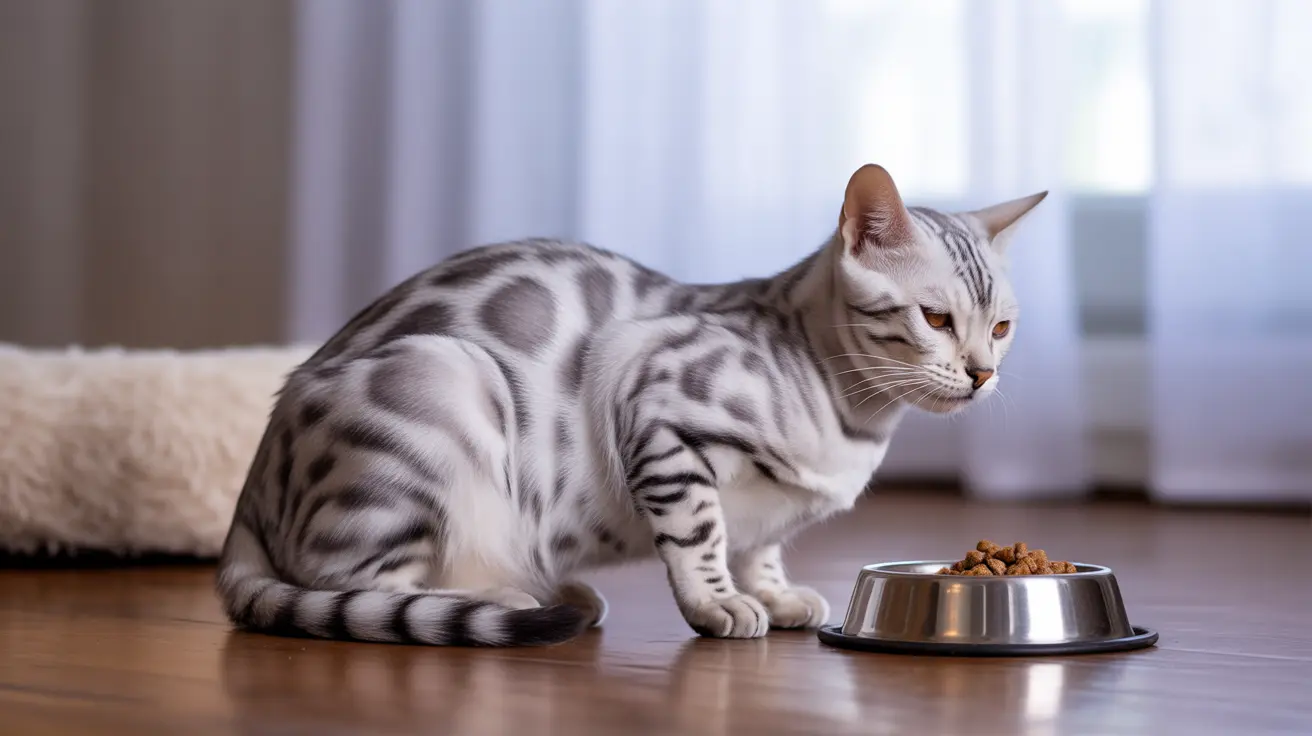Understanding Cat Vomiting vs. Regurgitation
When it comes to feline digestive disturbances, understanding the difference between vomiting and regurgitation is crucial for every cat owner. These two distinct conditions, while sometimes appearing similar, require different approaches to treatment and management. Recognizing their unique characteristics can help you provide better care for your feline companion and know when to seek veterinary attention.
As devoted cat parents, we often witness our pets experiencing various digestive issues. While occasional upsets are normal, knowing how to distinguish between vomiting and regurgitation can make a significant difference in your cat's health outcomes. This comprehensive guide will help you understand these conditions, their causes, and appropriate responses to ensure your cat's wellbeing.
The Fundamental Differences Between Vomiting and Regurgitation
Cat vomiting and cat regurgitation are two distinct physiological processes that require different approaches to treatment. Understanding these differences is essential for proper pet care and for making informed decisions about your cat's health.
Characteristics of Cat Vomiting
Vomiting is an active process involving forceful contractions of the abdominal muscles, which generally makes the event more dramatic and observable. When a cat vomits, you can typically expect the following signs:
- Visible signs of nausea before the event, such as restlessness or licking lips
- Drooling and repeated swallowing
- Active retching and heaving motions
- Expelled material showing signs of digestion, which may include partially digested food or fluid
- Presence of bile or stomach acids, often giving the vomit a yellow or greenish tinge
In summary, vomiting is a forceful and visible process, often preceded by warning signs that give pet parents a chance to intervene or observe carefully.
Understanding Cat Regurgitation
On the other hand, regurgitation is a passive process where food is expelled without any effort from the abdominal muscles. Typically, regurgitation occurs soon after eating, and the cat may seem completely normal before it happens:
- No warning signs or preliminary behavior, making it seem sudden
- Food comes up easily and quickly, often without any noise or discomfort
- Content appears undigested, often resembling the original form of the food
- Often occurs shortly after eating or drinking
- No bile is present in the expelled material, which means it is less acidic and less irritating to the esophagus
Because regurgitation is so sudden and passive, it can sometimes be mistaken for vomiting, but the absence of warning signs and the nature of the expelled food are key differences.
Common Causes of Feline Vomiting
Vomiting in cats can be triggered by a range of medical or environmental factors. Understanding these common causes can help pet parents address and potentially prevent vomiting episodes in their cats.
Medical Causes
Chronic vomiting may indicate an underlying medical condition. Some of the most common medical reasons include:
- Inflammatory bowel disease: Inflammation of the gut can lead to frequent vomiting, weight loss, and changes in appetite.
- Kidney disease: Compromised kidney function leads to toxin buildup, resulting in nausea and vomiting.
- Hyperthyroidism: Overactive thyroid glands can affect digestion, leading to gastrointestinal upset.
- Parasitic infections: Intestinal parasites may cause irritation or blockage, leading to vomiting episodes.
- Pancreatitis: Inflammation of the pancreas disrupts digestion, frequently causing vomiting and inappetence.
Environmental and Dietary Factors
Not all vomiting is caused by disease; sometimes, the culprit is environmental or related to eating habits:
- Dietary indiscretion, where a cat eats something inappropriate or spoiled
- Food allergies or sensitivities, especially to new ingredients
- Hairballs resulting from the natural grooming process
- Foreign object ingestion, such as small toys, strings, or plants
- Rapid eating, which can overwhelm the stomach and trigger vomiting
Careful observation of your cat's environment and diet can help prevent these common triggers.
Understanding Regurgitation in Cats
Regurgitation usually stems from physical or behavioral factors affecting the esophagus or the process of swallowing food. Unlike vomiting, the root causes are often located higher up in the digestive tract.
Physical Causes
Physical issues involving the esophagus often result in regurgitation. Common causes include:
- Esophageal disorders, such as structural abnormalities or weakness in the esophageal muscles
- Megaesophagus, a condition where the esophagus is enlarged and lacks normal movement to push food into the stomach
- Strictures, which are narrowings of the esophagus usually caused by injury, inflammation, or scarring
- Inflammatory conditions of the esophagus (esophagitis) leading to discomfort and improper movement of food
- Foreign objects stuck in the esophagus, which create an obstruction and prevent food from progressing normally
Behavioral Factors
Sometimes, a cat's behavior around food can contribute to regurgitation:
- Eating too quickly, which can prevent food from being chewed and swallowed properly
- Stress during meals, such as competition with other pets or hectic environments
- Excitement while eating, making the cat swallow too much air or food at once
- Competition with other pets, leading to rushed and anxious eating
- Anxiety-related feeding issues, where emotional stress interrupts normal swallowing
Addressing the environment during meal times and identifying potential stressors can play a key role in minimizing regurgitation episodes.
When to Seek Veterinary Care
While not every episode of vomiting or regurgitation is an emergency, certain signs should lead to prompt veterinary evaluation. If you observe any of the following symptoms in your cat, it's best to consult a veterinarian:
- Frequent episodes (more than once daily), which could indicate a serious problem
- Blood in vomit, a possible sign of gastrointestinal injury or severe illness
- Lethargy or depression, showing that your cat is not feeling well overall
- Loss of appetite lasting more than 24 hours
- Signs of dehydration, such as sunken eyes, dry gums, or skin tenting
- Noticeable weight loss over a short period
- Concurrent diarrhea or changes in stool, indicating a more widespread digestive disturbance
It's always better to err on the side of caution with persistent or severe symptoms. Early intervention can greatly improve outcomes for your cat.
Prevention and Management Strategies
Implementing effective preventive strategies can keep both vomiting and regurgitation episodes to a minimum. Consider integrating these practical steps into your cat’s daily routine:
- Feed small, frequent meals instead of large ones to ease digestion
- Use elevated feeding bowls when appropriate, especially for cats prone to regurgitation
- Implement slow-feeding solutions, such as puzzle feeders, to decrease the rate of eating
- Maintain regular grooming routines to reduce hairball formation, especially in long-haired breeds
- Keep potentially harmful objects out of reach to prevent accidental ingestion
- Monitor eating habits and behavior, making adjustments as needed to improve your cat's comfort and safety
Consistency and attentiveness in feeding routines and environment can make a significant difference in managing your cat’s digestive health.
Frequently Asked Questions
- What is the main difference between vomiting and regurgitation in cats? Vomiting involves abdominal effort and usually expels digested or partially digested food; regurgitation is a passive process that brings up undigested food with no abdominal contractions.
- What causes vomiting in cats? Common causes include hairballs, dietary indiscretion, infections, exposure to toxins, and chronic illnesses like kidney or thyroid disease.
- What causes regurgitation in cats? Regurgitation is usually due to esophageal problems, rapid eating, or the presence of foreign objects in the esophagus.
- When should I take my cat to the vet for vomiting? Veterinary attention is warranted for frequent or severe vomiting, presence of blood, or symptoms such as lethargy, appetite loss, or dehydration.
- What are typical symptoms of vomiting in cats? Classic signs include retching, drooling, abdominal heaving, and expulsion of stomach contents that may contain bile.
- What are typical signs of regurgitation in cats? Regurgitation often happens suddenly without warning, and expelled food is undigested and expelled passively.
- Can diet changes help prevent vomiting in cats? Gradual changes to the diet and offering smaller, more frequent meals can help minimize digestive upset and vomiting.
- Are hairballs a common cause of vomiting? Yes, hairballs are a frequent and often benign reason cats vomit, especially in those that groom themselves frequently.
- Is regurgitation in cats an emergency? While not always an emergency, persistent or severe regurgitation—especially if associated with difficulty breathing or swallowing—requires prompt veterinary evaluation.
- Can chronic vomiting indicate a serious disease? Chronic vomiting may be a sign of a serious underlying illness and should always be assessed by a veterinarian.
Conclusion
Understanding the differences between vomiting and regurgitation in cats is crucial for providing appropriate care and knowing when to seek veterinary attention. By staying informed and observant, you can help ensure your feline friend maintains optimal digestive health and overall well-being. Remember, while some cases can be managed at home through dietary changes and preventive measures, persistent or severe symptoms should always be evaluated by a professional to prevent complications and support your pet's best possible health.






